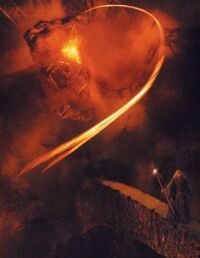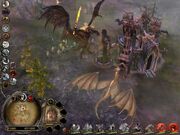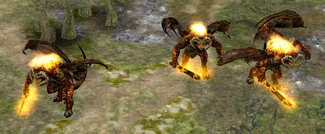(→History: typo fix) |
(→Trivia) |
||
| Line 99: | Line 99: | ||
*War, the first horseman and main playable character from the game Darksiders has a chaos form that looks very similar to Durin's Bane. |
*War, the first horseman and main playable character from the game Darksiders has a chaos form that looks very similar to Durin's Bane. |
||
*Balrog was the name of '''a boxer''' from USA who made his debut as the second boss in ''[[wikipedia:Street Fighter II|Street Fighter II]]''. Although he cannot kick, he made up for it with pummeling punches. This name was originally part of a triangle of replacement; the original Japanese game credited him as M. Bison (after boxer Mike Tyson), leaving the character Vega named Balrog. |
*Balrog was the name of '''a boxer''' from USA who made his debut as the second boss in ''[[wikipedia:Street Fighter II|Street Fighter II]]''. Although he cannot kick, he made up for it with pummeling punches. This name was originally part of a triangle of replacement; the original Japanese game credited him as M. Bison (after boxer Mike Tyson), leaving the character Vega named Balrog. |
||
| − | *In the manga and anime series Saint Seiya |
+ | *In the manga and anime series Saint Seiya, Balrog Rune (or "Balron Lune") is a servant of Hades clad in armor modeled after Tolkien's monster. |
*The '''Juggernaut''' and it's upgrade the '''Ravager''' in Heroes VI, also resembles the Balrog's looks. Especially the head region. Whether this is on purpose or just a coincidence is not known. |
*The '''Juggernaut''' and it's upgrade the '''Ravager''' in Heroes VI, also resembles the Balrog's looks. Especially the head region. Whether this is on purpose or just a coincidence is not known. |
||
Revision as of 22:43, 16 November 2013
- "Then something came into the chamber - I felt it through the door, and the orcs themselves were afraid and fell silent. It laid hold of the iron ring, and then it perceived me and my spell."
- —Gandalf
Balrogs were Maiar spirits seduced by Melkor, and may have taken demon-like form as a result. They are demons of shadow and flame. Melkor corrupted these Maiar to his service but there were never more than seven according to Tolkien's son. However, in earlier versions of his writings there are references to entire "armies" of Balrogs. Gothmog was their captain during the 1st Age.
- (Note: Many pictures on this page are of Durin's Bane, the Balrog of Moria; Durin's Bane is only the most well-known example of multiple different Balrogs.)
- Note: For theories about whether Balrogs had actual wings, go to the Did Balrogs have wings? page.
Origins
The Balrogs were originally Maiar (and therefore also Ainur), of the same order as Sauron and Gandalf, but they became seduced by Melkor, who corrupted them to his service in the days of his splendour before the creation of Arda. During the Music of the Ainur, Melkor (Morgoth) began introducing themes of his own design into the Theme of Ilúvatar, causing great discord in the music. The Balrogs were among those spirits near Melkor who attuned their own music to Melkor's theme rather than Ilúvatar's. Therefore, they not only existed before the creation of the world, they had a part in its creation.
History
During the First Age, they were among the most feared of Morgoth's forces. When his Fortress of Utumno was destroyed by the Valar, they fled and lurked in the pits of Angband. The Balrogs were first encountered by the Elves during the Dagor-nuin-Giliath (Battle-under-Stars) in the First Age. After the great victory of the Ñoldor over Morgoth's orcs, Fëanor pressed on towards Angband, but the Balrogs came against him. He was mortally wounded by Gothmog, Lord of Balrogs (the only Balrog known by name). Though his sons fought off the demons with an army of elves at their side, Fëanor died of his wounds soon after, and his spirit departed for the Halls of Mandos. Another major encounter was in the Battle of Unumbered Tears(Nirnaeth Arnoediad). Gothmog, High Captain of Angband, led the invasion. He threw aside Hurin and Turgon, turned upon Fingon and killed him with the help of another Balrog, winning the battle for Morgoth's forces. During the Fall of Gondolin, Ecthelion managed to kill Gothmog at the cost of his own life. Another Balrog is confronted when he attacks Tuor and those attempting to escape the siege. Glorfindel fought the Balrog to give his friends a chance to escape. The battle ended with Glorfindel casting down the Balrog from the mountain but being pulled down along with the demon. The last Balrogs fought in the War of Wrath but were either slain or forced to retreat.
The Balrogs were supposed to have been all destroyed at the end of the First Age, but during the Third Age, it was discovered that at least one had escaped and hidden deep beneath the Misty Mountains, near Moria -- Durin's Bane, probably the best-documented of the Balrogs. The Dwarves of Khazad-dum had accidently awakened it while greedily minning too deep for Mithril. It was Durin's Bane that drove the dwarves from their homeland in Moria. Later, in his confrontation with the wizard Gandalf and the the Fellowship of the Ring, he pursued them to the bridge of Khazad-dûm. Gandalf fought the Balrog allowing the Fellowship to escape Moria in The Lord of the Rings (described specifically, in Book II Chapter 5, the second half of The Fellowship of the Ring), both were slain, but Gandalf was "sent back" by the Valar (or possibly by Iluvatar).[1]
Appearance

The Balrog's Whip
A Balrog was a tall (possibly some 14 feet high), menacing being in the shape of a Man, having control of both fire and shadow and with a fiery whip with several thongs (Gothmog, the Lord of Balrogs in the First Age used an axe as well). They induced great terror in friends and foes alike and could shroud themselves in darkness and fire. Many who have faced Balrogs referred to them as "creatures of fire and shadow" or simply "shadow and flame."
They are humanoid, and very intelligent creatures (being Ainur, they took part in the creation of the world).
In the books, Tolkien depicts the Balrog as being barely a shape wreathed in shadow and flame - possibly man-shape, yet greater. Balrogs seemed to encapsulate and project power and terror.
Miscellaneous

A Balrog from The Battle for Middle-earth attacks
In one of Tolkien's pre-Middle-earth stories, Lay of the Children of Húrin, "Lungothrin, Lord of Balrogs" is mentioned. It is not, however, certain if it was another name for Gothmog, or it simply meant "a Balrog lord". According to Christopher Tolkien, the latter is more probable, as the name Gothmog was mentioned in the earliest Middle-earth writings, as well as the final version of Tolkien's mythology.
The Balrogs were originally envisioned as being immense in number:
The early conception of Balrogs makes them less terrible, and certainly more destructible, than they afterwards became: they existed in 'hundreds' (p. 170), and were slain by Tuor and the Gondothlim in large numbers: "thus five fell before Tuor's great axe Dramborleg, three before Ecthelion's sword, and two score were slain by the warriors of the king's house." The Book of Lost Tales 2, commentary by Christopher Tolkien on The Fall of Gondolin.

Three demons of Melkor in BFME2
"There came wolves and serpents and there came Balrogs one thousand, and there came Glomund the Father of Dragons." The Lost Road, chapter 16. (Glomund's name became Glaurung when Tolkien wrote the Silmarillion.
When Tolkien developed Middle-earth as the backdrop for The Lord of the Rings, Balrogs became more formidable and terrible, this number was much reduced. In the end Tolkien stated that there were "at most" seven Balrogs:
"In the margin my father wrote: 'There should not be supposed more than say 3 or at most 7 ever existed.'" Morgoth's Ring, Section 2 (AAm*): note 50 (just before section 3).
The number of Balrogs changed to at most seven at the same time they "became" Maiar in Tolkien's mind. So this note is the only applicable indication of Balrog numbers that Tolkien wrote.
Two possibly died during the fall of Gondolin, four were destroyed during the War of Wrath and the last one by Gandalf at Moria.
Portrayal in adaptations
Video games
In the video games The Lord of the Rings: The Battle for Middle-earth and The Lord of the Rings: The Battle for Middle-earth II, the Balrog is a power of the goblins and Mordor which cost 25 Power points, with Whip, Sword, Wings, Firebreath and other weapons can cause devastating damage towards enemy units and structures. It is also a Boss character in The Lord of the Rings: The Fellowship of the Ring Video Game, The Lord of the Rings: The Two Towers on Game Boy Advance and The Lord of the Rings: The Third Age, In the latter, the Balrog is fought by Gandalf on the Player's side and becomes a usable hero for the duration of the battle. Though it is referenced in the video games based on the Films. It also appears in The Lord of the Rings: Aragorn's Quest, resembling the movie version. Two Balrogs also appear in The Lord of the Rings Online: Thaurlach, located deep within the Rift of Nurz Ghashu in Angmar, and Durin's Bane, encountered several times during introductive "quests" to Moria. An illusion of Durin's Bane is encountered in the Ost Dunhoth Instance Raid.
Card games
Balrog (named Firelord Balrog) appears in the game The Legend of the Cryptids as a playable card.
Etymology
The Quenya form is Valarauko or Valarauco (Tengwar: full spelling yEjE7.EaY or vowel-abbreviated spelling yj7.aY; IPA: [valaˈraʊko]), and the plural is Valaraukar or Valaraucar (Tengwar: full yEjE7.EaE6 or abbrev. yj7.a6; [valaˈraʊkar]). The Sindarin form was "Demon of Might"; IPA: [ˈbalroɡ]; Sindarin plural Belryg; [ˈbelryɡ] or later [ˈbelriɡ])
Gallery
Trivia
- At over 20 feet high, the Balrog is one of the largest characters in the Lord of the Rings franchise. Along with Gandalf, Saruman, Sauron, Radagast, Treebeard and possibly Tom Bombadil, he may very well be the oldest.
- Some fans of the Doom series claim that the Balrog of the movies looks similar to a cross between a D3 Cyberdemon and a D3 Maledict (Cyberdemon with Maledict Wings).
- A demonic monster in the popular 2D side-scrolling game Maplestory, bears many similar qualities and characteristics, and thus many believe the monster was represented on behalf of the fictitious one depicted in the Tolkien series.
- A certain red-skinned antagonist in the MMO-RPG Wartune is identical exactly to a Balrog but for his 4 black horns.
- A demon in Dungeon Hunter: Alliance called the Cremator has the same head and fiery presence as a Balrog, without wings.
- A demonic monster in another popular 3D game called Mabinogi.
- Many fans claim that the Balrog inspired Games Workshop's Bloodthirster in Warhammer, which is known as the Greater Daemon of Khorne (the Chaos God of Blood, Battle, War and Rage.)
- The main antagonist of Prince of Persia: Warrior Within, the Dahaka, strongly resembles the Balrog, but has one horn bent downward, and it does NOT have wings.
- The Balor from Dungeons and Dragons is clearly based on the Balrog.
- In early editions of the game, it was actually referred to as the Balrog. The name was changed due to copyright claims made by Tolkien Estate.
- The hero named Hellbringer from Heroes of Newerth (A game that is based on a popular Warcraft III mod known as Defense of the Ancients.) can summon Malphas which is clearly based on the Balrogs.
- War, the first horseman and main playable character from the game Darksiders has a chaos form that looks very similar to Durin's Bane.
- Balrog was the name of a boxer from USA who made his debut as the second boss in Street Fighter II. Although he cannot kick, he made up for it with pummeling punches. This name was originally part of a triangle of replacement; the original Japanese game credited him as M. Bison (after boxer Mike Tyson), leaving the character Vega named Balrog.
- In the manga and anime series Saint Seiya, Balrog Rune (or "Balron Lune") is a servant of Hades clad in armor modeled after Tolkien's monster.
- The Juggernaut and it's upgrade the Ravager in Heroes VI, also resembles the Balrog's looks. Especially the head region. Whether this is on purpose or just a coincidence is not known.
| This page uses content from Wikipedia. The original article was at Balrog. The list of authors can be seen in the page history. As with The One Wiki to Rule Them All, the text of Wikipedia is available under the Commons Attribution-Share Alike license. |
References
External links
 Balrogs at Tolkien Gateway
Balrogs at Tolkien Gateway- The Truth About Balrogs essay series by Conrad Dunkerson.





